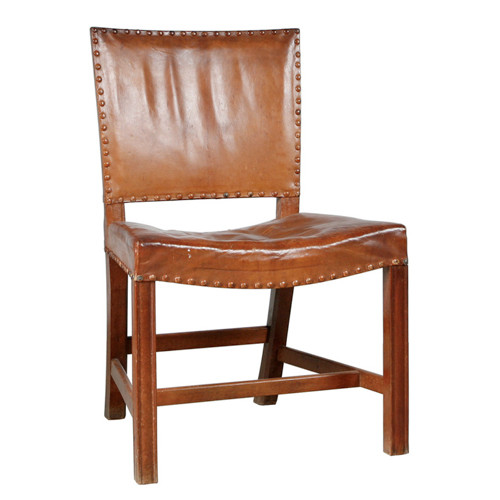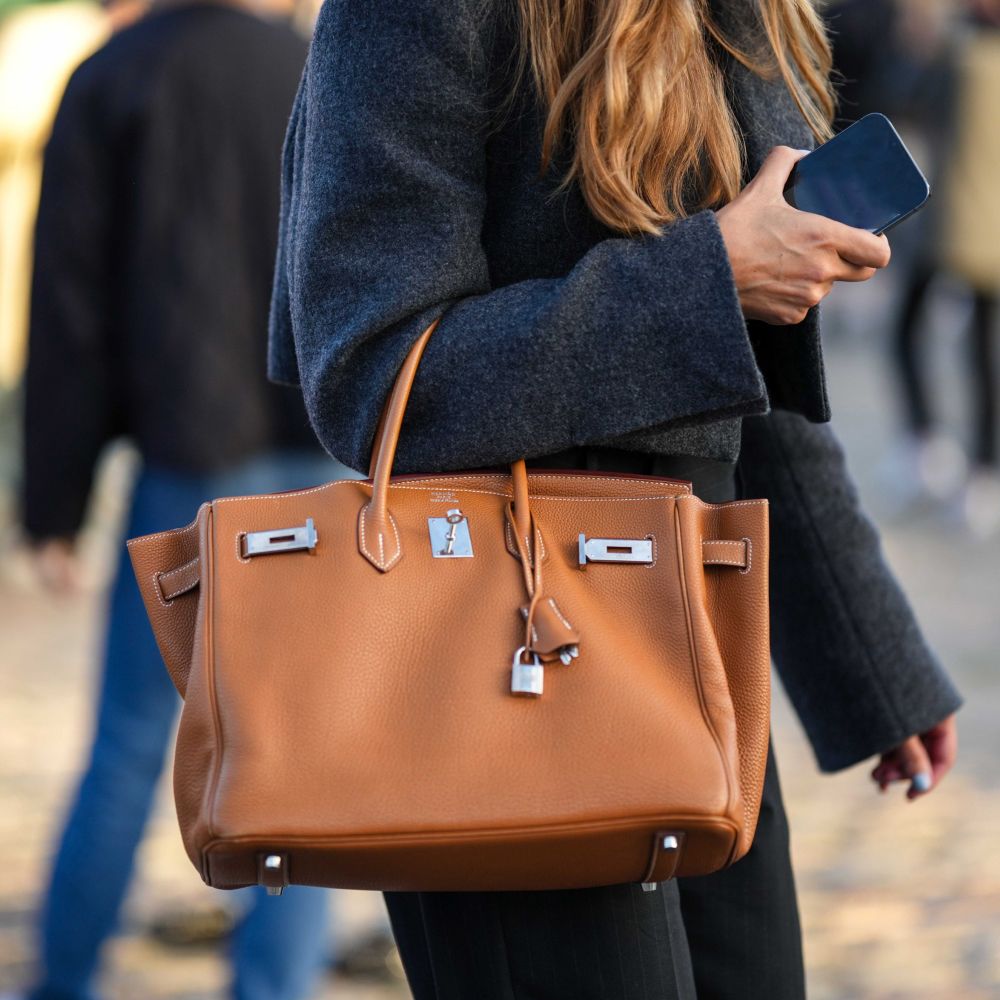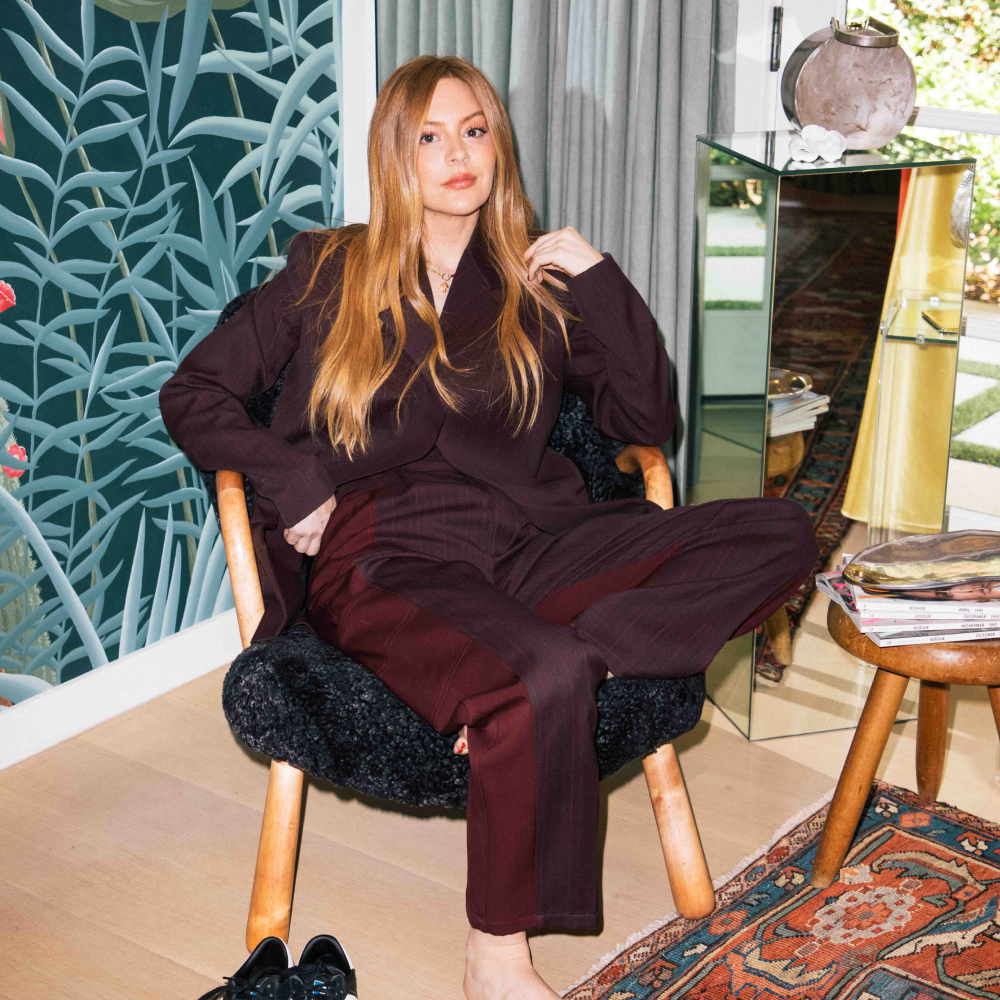
September 2014Reed and Delphine Krakoff pose in front of a Morris Louis painting, one piece from their expansive art collection, in their former Manhattan townhouse on East 70th Street. Photo by Kristine Larsen
On a recent warm summer morning, Reed Krakoff is recollecting how some 15 years ago he and his now-wife, Delphine, were in Paris, her hometown, trolling antiques stores. “This was the old days, before 1stdibs,” Reed jokes between spoonfuls of yogurt and granola at the restaurant of The Mark hotel on Manhattan’s Upper East Side. “I saw a pair of chairs that looked like Jean-Michel Frank” but were marked in a more generic way. “They were sitting in the middle of a bunch of Louis XVI. While Delphine was distracting the dealer, I flipped over a chair and pulled back the lining on one.” Reed pauses, milking the cloak-and-dagger suspense. “And it was actually signed, ‘Jean-Michel Frank.’ ”
Hardly able to contain their glee, the Krakoffs politely paid the asking price, which wasn’t much, and loaded their finds into their hired car. Delphine, cute behind round, black-rimmed eyeglasses, her dark hair pulled back in a ponytail, animatedly picks up the thread: “I’m sitting on Reed’s lap in the front because there’s no room in back, of course. And we’re stopped by the police! We explained our predicament. The police gave us an escort to the shipper!”
Reed, the former executive creative director and president of Coach who is now focusing on his eponymous fashion collection, has been acquiring Frank for more than 20 years, and he certainly knows his stuff. But that’s almost beside the point. Plenty of couples take up hobbies together: golf, say, or bird-watching. Reed and Delphine, however, commune about their shared interest — design — with such an uncommon passion that even a discussion about door hinges can sound romantic. Acquiring fabulous houses, meticulously renovating them and filling them with exquisitely chosen furniture and art seems the very core of the Krakoffs’ relationship. In their 11-year marriage they have already transformed nine properties, beginning with a brownstone on East 61st Street when they were newlyweds. At the moment they’re working on not one but two more: a Federal townhouse on the Upper East Side and a sprawling wooded estate in New Canaan, Connecticut, that belonged to the batty late heiress Huguette Clark.

A Manhattan townhouse Delphine recently designed features Gio Ponti club chairs and lighting by Ronan and Erwan Bouroullec from Kreo in Paris. Photo by Cari Voung, courtesy of Pamplemousse Design
Design is their business, of course. Years ago Delphine transitioned from being an accessories designer to an interior decorator and 1stdibs antiques dealer, with a storefront called Pamplemousse. There’s no grand Krakoff theory of decorating or collecting. “We just buy what we love,” Reed says. Their taste is indeed catholic, ranging from Tiffany lamps to Mark Newson furniture. They collect Queen Anne period — the last quarter of the 18th century, Boston, Reed specifies, because of its modern lines — as well as contemporary Ron Arad and Joris Laarman pieces. They are voracious collectors, but their holdings are not encyclopedic: When they like a designer, they tend to buy in depth. Figuring out which of their many properties — Paris, East Hampton, Palm Beach — in which to place a new find does not pose a problem. “Each house has a different history, architecture and personality,” Delphine says. “When we find something we love, we automatically know which house it belongs to.”

The couple’s latest project is a 14,000-square-foot mansion known as the Clark Estate, in New Canaan, Connecticut. Photo courtesy of Barbara Clearly Realty

In the Reed Krakoff Madison Avenue flagship store on New York’s Upper East Side, shoppers can sit on couches designed by Reed and Delphine and Joris Laarman chairs.
The Krakoffs compare renovating and decorating a house to telling a story. “Finding amazing spaces and bringing back to life what once was or could have been — that’s also a passion of ours,” Delphine says. Adds Reed, “When you’re renovating a house, it kind of tells you what it wants to be.” Case in point: Delphine calls the Upper East Side townhouse they’re now overhauling “the first masculine one we’ve done.” To that end, they’re going with stone, brick and more manly hardware. “We don’t have one style,” Reed says. After they’d started work on it, the Clark estate fell into their laps. “We weren’t looking for another house to do. One at a time is enough,” says Delphine. But after the couple saw the grand, 14,000-square-foot French-style chateau, they scooped it up. The house — which the eccentric Clark never actually moved into, apparently keeping the mansion on 52 acres as a sort of bunker in case of nuclear attack — had sat virtually untouched for 60 years. The Krakoffs intend to update the home respectfully. “We always try to make a house look like we did nothing,” says Reed.
They gave their first townhouse a 1930s-esque modernist French flair, while at Lasata, their East Hampton retreat — and Jackie Kennedy’s childhood summer home — Reed discovered original Arts and Crafts paneling beneath ornate Louis XVI paneling installed in the 1970s, so they promptly pulled off that outer layer. Their goal, however, is not to do what Reed refers to as “science projects,” or to create a by-the-book period piece. “We’re not academic in that way,” he says. “It’s a funny mix of being authentic and being romantic.”

A Lalanne alligator chair, an Alexander Calder mobile, a Guy de Rougemont coffee table and an Adolph Gottlieb panting are among the many standout pieces in the couple’s former 70th Street home. Photo courtesy of Pamplemousse Design
It was widely reported that the Krakoffs paid $14 million this past spring for the Clark property, $20 million below the asking price. Meanwhile, earlier this year, they sold for $51 million their previous Upper East Side townhouse, which encompassed 18,000 square feet and featured a spectacular staircase that swept through the home’s seven stories. Reed and Delphine bristle at the local press’s fixation on the prices of their real-estate transactions and insist that their design habit is not about speculation. “It’s about working on something together creatively,” Reed says.
Delphine intends for them to move into the Connecticut manse by Christmas. But don’t expect the Krakoff clan — which includes their three young children and his daughter from a previous marriage — to inhabit either their new city or country dwellings for long. “Once we live in it a couple of years, we’re like, eh,” Delphine says. “We’re excited to do another.”
Though the Krakoffs are close collaborators, each does play his or her special role. “I can’t do what she does,” Reed says. “I’m good at putting things where they look good, but I’m not good at planning a space.” He praises Delphine’s ability to create a house that their family can actually live in. “The chicest houses I’ve been in, you can do anything in them. The worst houses — and there are a lot of them — you stand in the living room, and it looks beautiful, but it’s just a showplace.” Says Delphine, “I really think spaces have personalities. It has nothing to do with feng shui or any of that crap.”

Portraits of the Krakoffs by Julian Opie hang in their Paris home. Photo by Reed Krakoff
Art is another essential element to the narrative. “You can’t just plug in the art,” says Reed, who was once a painting student at the School of the Museum of Fine Arts in Boston (while earning his degree at Tufts University) and has a sideline as a photographer, shooting his ad campaigns and publishing books of portraits. His taste now runs to Abstract Expressionist and Color Field painters, including Helen Frankenthaler, Robert Motherwell, Kenneth Noland and Al Held, as well as the influential early abstract artist Josef Albers and the minimalist Frank Stella. Calder mobiles hang from the ceiling, and Lalanne sheep can be found grazing the halls. In one house, there was only sculpture, with nothing on the walls; for another, Reed made a major study of sculpture gardens before devising his own.
Then there’s Delphine’s large trove of fashion illustrations and Reed’s substantial book collection, which he estimates to include “thousands” of mostly visual volumes. “Every house we’ve ever done has had a library,” he says. “It’s always the center of our home.” Ceramics are also in the mix, from pieces by George Ohr, the “Mad Potter of Biloxi,” to Harumi Nakashima, whose bulbous forms are typically covered in dots. Acquiring the best, no matter the medium, is essential. “I don’t want third-rate,” Reed says.
Art influences have a way of seeping into Reed’s fashion collection. “It’s all part of this cultural map,” he says. He launched Reed Krakoff, trumping Coach on luxury terms, in 2009 and won the prestigious CFDA accessories award for it in 2012 (his third such award). One thing Reed knows about as well as anyone is handbags, and he’s preparing to debut what he boldly declares is his favorite ever: the RK40. But he has also been gaining traction in ready-to-wear. Michelle Obama, who famously donned a blue Reed Krakoff dress and cardigan when President Obama was sworn in for his second term, wore one of his sleeveless frocks for her 2013 Vogue cover and chose a two-tone number of his for her recent official White House portrait.

“It’s a different kind of collection,” Reed told Style.com about his Fall 2014 line, seen here. “I started with the idea of seasonlessness. Nobody dresses that way anymore.” Photos by Reed Krakoff

The new limited-edition RK40 bag in alligator.
Since leaving Coach last year, Reed has been devoting his full attention to this namesake line. “I had a great career there, but it was time,” he says. “I needed to focus on one thing.” The richly textured collection offers an elevated take on American sportswear, or what Reed calls “utilitarian luxe.” (Think leather-trimmed “sweatshirts” and sleeveless fur tops.) For spring — which he’ll present privately next week, in what he describes as more of an installation than a big runway extravaganza — he’s putting an emphasis on 21st-century lace. “It’s coming from these contemporary, perforated materials that have an industrial feel to them, like mesh, honeycomb,” he says. “That’s brought together with a palette taken from leather goods: these natural, undyed, unbleached colorations.”
It’s clear from talking to Reed, though, that he eschews the title fashionista. “I’m not a fashion designer; I’m a designer,” he says, echoing what has become his motto. “I like creativity.” Whether creating a skirt or mapping out a sculpture garden, his approach stems from the same desire: “Everything is a fanatical focus — learning everything I can.”










